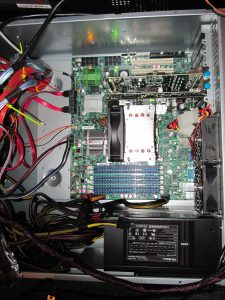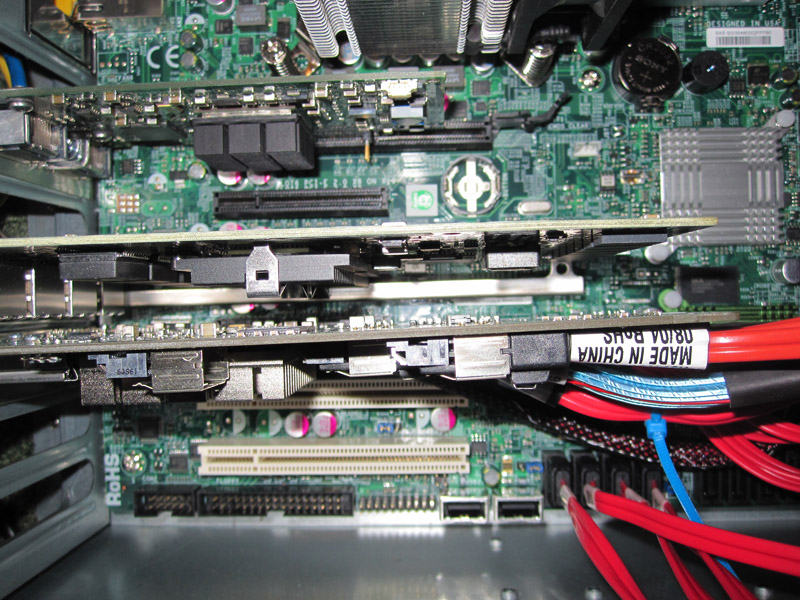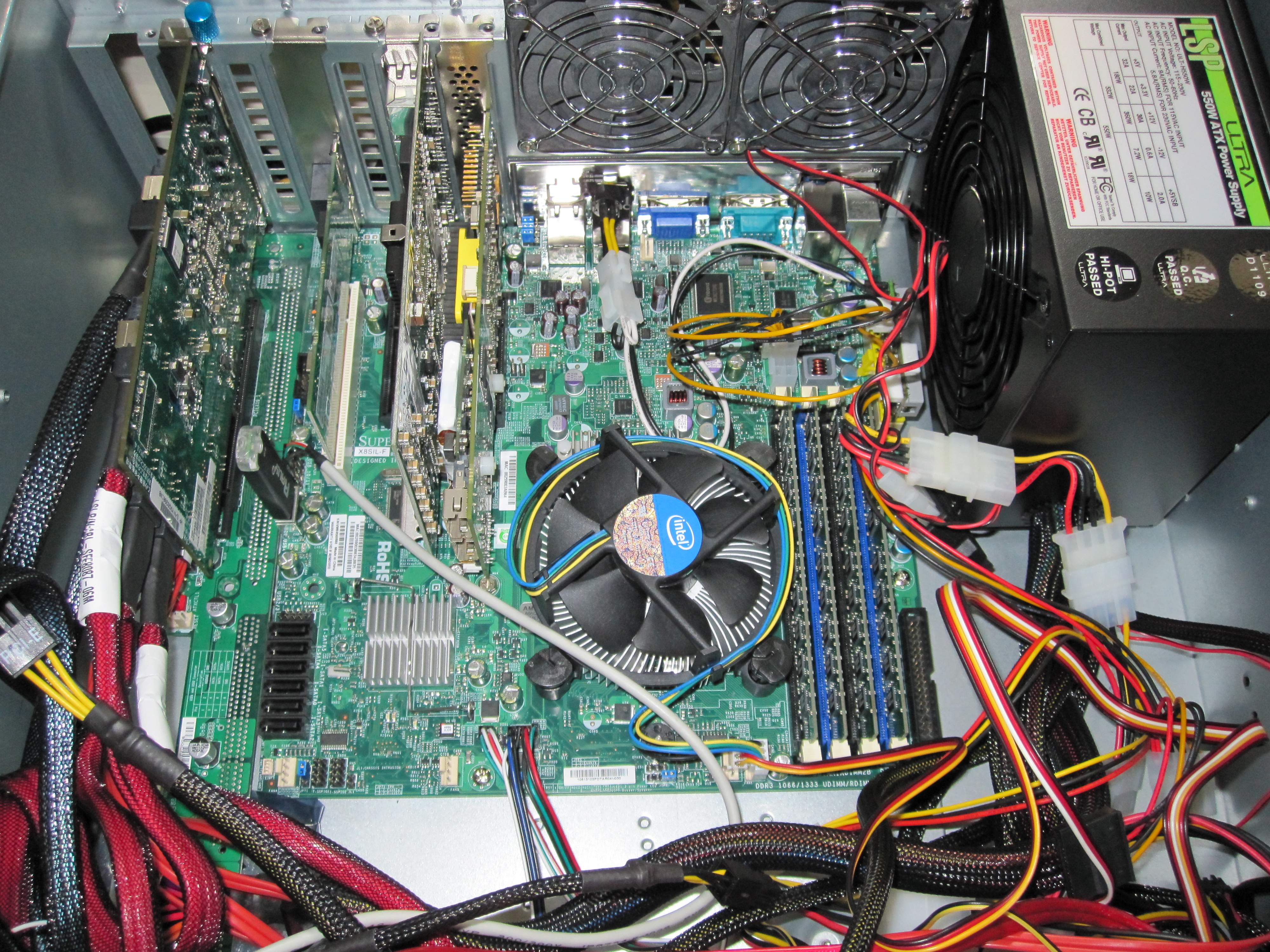This week the Big WHS underwent a major change and dropped the Asus motherboard in favor of a Supermicro one. Apparently the Asus P6T7 WS Supercomputer motherboard does not like the HP SAS Expander at all. I could not find a card that could see the SAS Expander. This all culminated when I finally took the working setup out of the Gigabyte H55 board and couldn’t get it to work in the Asus. For those wondering, yes, it was a $200 motherboard/ CPU with 36 raid ports + another 5 onboard and 1 esata. Windows Home Server v1 can only support 32 drives so that is a lot of connectivity at about $660!
The decision not to use the Asus left me with a void in what to use motherboard wise for the big WHS. I gave some thought of just using the Gigabyte H55 mATX + the i5-650, but then realized that I would probably want more in the near future. At this point, I just want things to work so I ordered the Supermicro X8ST3-F The board is pretty cool in that it has a lot of PCIe slots, integrated video (16MB which these days sounds more like a CPU cache amount but alas), Intel LAN, and most importantly IPMI 2.0! It is somewhat scary that the WHS is going to take up 8 ports on the switch when it is done.
Here is a quick picture of the new Supermicro board installed with 12GB of DDR3, an Areca 1680LP, and a HP SAS Expander card. Other add-ins such as an Intel Pro/1000 PT Quad, and such were not installed at this point.

I will write a review after I get a chance to use the board a bit more. Right now I am loving the IPMI 2.0 which is a big step up from the remote server management I could do on the Asus board. Further, the new Supermicro has a generous amount of PCIe slots which makes it ideal for adding multiple raid cards, HBAs, and/or quad port NICs.




I had no idea what IPMI 2.0 was before I googled it. Looks very cool, fun to play around with hah. Now since you went with a legit server motherboard I feel like you should have grabbed a Xeon instead of the 920, and some ECC ram. But oh well, if it works well that’s great. Does everything work fine now? Including the HP SAS card?
IPMI is great, but the response is slower than with RDC. The plus side is you can remotely get to the system even during BIOS POST. Plus, it is way better than a KVM. I think Intel’s new vPro is going to have similar features.
Everything is working well. I switched to the Areca ARC-1680LP to provide the SATA/SAS ports, and it plays nicely with the HP SAS Expander. The Adaptec cards need an older version of the HP SAS Expander firmware (v1.0 versus 2.02 is the current revision) which is fine, but the 1680LP has one SFF-8087 (internal) and one SFF-8088 (external) port. Since I’m going to have one expander internal (Norco RPC-4020) and one external (in the RPC-470) it was the best setup I had on hand.
I’ll post more info this week.
I copied over 3TB worth of courtroom/ witness preparation footage and that all works fine. Also, copied a few gigs of files over, installed add-ins for WHS,
Ah, now I see why you need so much storage. I recently discovered that my ISP offers 100GB free FTP storage to all its customers (I got a 2nd internet line for torrents). I set it up with Syncback Pro to backup the most important stuff to me and it works like a charm, just slowish (5mbps down, 0.8up). Do you also do any offsite backups?
I back up to a different building down the block. In California, I figure that if there is a big enough earthquake to knock both structures out, I have bigger problems. Ultra important documents are backed up online, but those are mostly MS Office format and not very big. Doing multi-GB backups online is a bit prohibitive just because it takes so long to up/ download things.
Interested to know how your getting on with this as I’ve just ordered an X8ST3-F for my own WHS build
It is a GREAT board! I love the thing. It is certainly not a basic WHS board since really an LGA 1366 chip + the 6 DIMM slots, multiple PCIe slots and etc are overkill for an OS that runs really well on two of the i7’s 8 logical cores and with 4GB of ram or less. If you are filling a Norco RPC-4020 though, the 14 onboard SATA slots, plus a supermicro 8 port card ($99) make this a great option. If I wanted to build something that used less power, but was similarly capable I would get a Supermicro X8SIE-LN4F with an i5-650 using the two PCIe slots for SATA cards.
If you need any help let me know. Also, if you’ve never used a Supermicro board or anything with IPMI before, get excited! I have never hooked up a monitor/ keyboard/ mouse to this thing.
Great setup. I’m looking to build a massive WHS. I’m going to wait to see what comes about with Vail. Do you see yourself putting together a guide with hardware suggestions as well as how to setup RAID 6 on a system using WHS. I may go the HV route with W7 if MyMovies doesn’t produce an add-in for Vail for backing up my Blu-ray collection. I definitely want the Norco 4220 or 4020 with RAID 6. I’m willing to pay for server quality hardware. Other question, I was under the belief that WHS can only make use of one NIC and that combining multiple NICs even with a commercial grade router wouldn’t have any performance benefit. Am I totally wrong??
@ ER_Dr: Even if WHS did not have a Vail add-in for MyMovies, you could do a “server” installation of MyMovies on Vail and run the database on that. Run collection management either on the Vail system, a Win 7 workstation, or in a Hyper-V VM. The Norco RPC-4220 and RPC-4020 are great enclosures (the Big WHS is now using both) and I am a fan of RAID 6. I have not had a chance to run raid 6 on Vail yet to really test that out. Your other question on the multiple NICs is that you can (remember WHS V1 is a Windows 2003 kernel), but it is not super easy. One reason you may have heard that it does not work is that usually when you use Drive Extender v1 instead of Raid underneath, you are usually limited to the performance of a single disk, hence the average sequential read/ write throughput is going to be just about the same speed as gigabit ethernet. I actually found that it was better to just use one Realtek NIC in WHS. Keep checking back or subscribe to the RSS feed. I will have an update on the Big WHS in the next few days.